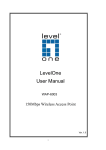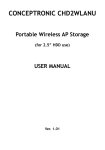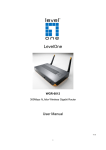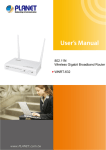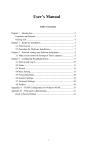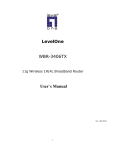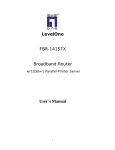Download LevelOne WAP-6003
Transcript
LevelOne User Manual WAP-6003 150Mbps Wireless Access Point Ver. 1.0 1 Safety FCC WARNING This equipment may generate or use radio frequency energy. Changes or modifications to this equipment may cause harmful interference unless the modifications are expressly approved in the instruction manual. The user could lose the authority to operate this equipment if an unauthorized change or modification is made. This equipment has been tested and found to comply with the limits for a Class B digital device, pursuant to Part 15 of the FCC Rules. These limits are designed to provide reasonable protection against harmful interference in a residential installation. This equipment generates, uses, and can radiate radio frequency energy and, if not installed and used in accordance with the instructions, may cause harmful interference to radio communications. However, there is no guarantee that interference will not occur in a particular installation. If this equipment does cause harmful interference to radio or television reception, which can be determined by turning the equipment off and on, the user is encouraged to try to correct the interference by one or more of the following measures: 1) Reorient or relocate the receiving antenna. 2) Increase the separation between the equipment and receiver. 3) Connect the equipment into an outlet on a circuit different from that to which the receiver is connected. 4) Consult the dealer or an experienced radio/TV technician for help. CE Declaration of conformity This equipment complies with the requirements relating to electromagnetic compatibility, EN 55022 class B for ITE, the essential protection requirement of Council Directive 89/336/EEC on the approximation of the laws of the Member States relating to electromagnetic compatibility. CE Marking Warning Hereby, Digital Data Communications, declares that this product is in compliance with the essential requirements and other relevant provisions of Directive 1999/5/EC. The CE-Declaration of Conformity can be downloaded at: http://www.levelone.eu/support.php 2 NCC Marking Warning 第十二條 型式認證合格之低功率射頻電機,非經許可,公司、商號或使用者均不得擅自變更頻率、加大 功率或變更原設計之特性及功能。 第十四條 低功率射頻電機之使用不得影響飛航安全及干擾合法通信;經發現有干擾現象時,應立即停用, 並改善至無干擾時方得繼續使用。 前項合法通信,指依電信法規定作業之無線電通信。 低功率射頻電機須忍受合法通信或工業、科學及醫療用電波輻射性電機設備之干擾。 General Public License This product incorporates open source code into the software and therefore falls under the guidelines governed by the General Public License (GPL) agreement. Adhering to the GPL requirements, the open source code and open source license for the source code are available for free download at http://global.level1.com. If you would like a copy of the GPL or other open source code in this software on a physical CD medium, LevelOne (Digital Data Communications) offers to mail this CD to you upon request, for a price of US$9.99 plus the cost of shipping. 3 Table of Contents Chapter 1 Introduction ...............................................................................................5 1.1 Packing List ..................................................................................................5 1.2 Spec Summary Table ..................................................................................5 1. Package Information ..............................................................................................6 1.3 Hardware Configuration..............................................................................6 1.5 Procedure for Hardware Installation ...............................................................8 Chapter 3 Making Configuration ...........................................................................9 3.1 Login to Configure from Wizard ....................................................................9 3.2 System Status ............................................................................................12 3.3 Advanced ....................................................................................................13 Appendix A FAQ and Troubleshooting ...................................................................43 What can I do when I have some trouble at the first time?.................................43 How do I connect router by using wireless? .......................................................44 IP Address 192.168.1.1 Password admin Wireless Mode Enable Wireless SSID LevelOne Wireless Security None 4 Chapter 1 Introduction Congratulations on your purchase of this outstanding Wireless Broadband Router. This product is specifically designed for Small Office and Home Office needs. It is easy to configure and operate even for non-technical users. Instructions for installing and configuring this product can be found in this manual. Before you install and use this product, please read this manual carefully for fully exploiting the functions of this product. 1.1 Packing List WAP-6003 Power Adapter Antenna (x1) Network Cable Quick Installation Guide CD User Manual / Utility / QIG 1.2 Spec Summary Table Device Interface Ethernet LAN 5 x RJ-45 port, 10/100Mbps, auto-MDI/MDIX Antenna 2 dBi fixed antenna WPS Button /Wireless On For WPS connection and Enable “Wireless Function” Reset Button Reset to Factory Default setting LED Indication Status / LAN1 ~ LAN5/ WiFi Power Jack DC Power Jack, powered via external DC 5V/1A switching power adapter Wireless LAN (WiFi) Standard IEEE 802.11b/g/n-lite compliance SSID SSID broadcast or in stealth mode Channel Auto-selection, manually Security WEP, WPA, WPA-PSK, WPA2, WPA2-PSK WPS WPS (Wi-Fi Protected Setup) WMM WMM (Wi-Fi Multimedia) Functionality 5 Routing Protocol Static route, dynamic route (RIP v1/v2) Management SNMP, syslog, Administration Web-based UI, remote login, backup/restore setting Environment & Certification Package Information DC 5V/1A power adapter, Quick Installation Guide 1. Package Information Device dimension (mm) 185 x 119 x 32 mm Operation Temp. Temp.: 0~40oC, Humidity 10%~90% non-condensing Storage Temp. Temp.: -10~70oC, Humidity: 0~95% non-condensing EMI Certification CE/FCC compliance RoHS RoHS compliance *Specifications are subject to change without prior notice. 1.3 Hardware Configuration Figure 2-1 Front Panel Antenna Power Jack Auto MDI/MDIX RJ-45 Ports Automatically sense the types of LAN when connecting to Ethernet 6 Reset Button Wi-Fi LED Status LAN1~LAN5 WPS LED LEDs Button 1.4 LED indicators Status LED status Description Green in flash Device status is working. Green RJ45 cable is plugged Green in flash Data access Green WLAN is on Green in flash Data access Green in fast flash Device is in WPS PBC mode Green in dark Wi-Fi Radio is disabled LAN LED WiFi LED 7 1.5 Procedure for Hardware Installation Step 1. Attach the antenna. 1.1. Remove the antenna from its plastic wrapper. 1.2. Screw the antenna in a clockwise direction to the back panel of the unit. 1.3. Once secured, position the antenna upward at its connecting joint. This will ensure optimal reception. 1.Turn off the Power Switch first. Step 2 Insert the Ethernet cable into LAN Port: Insert the Ethernet patch cable into LAN port on the back panel of Router, and an available Ethernet port on the network adapter in the computer you will use to configure the unit. Step 4. Power on Router: 4.1. Connect the power adapter to the receptor on the back panel of your Router. Step 5. Complete the setup. 5.1. When complete, the Status LED will flash. 8 C Chhaapptteerr 33 M Maakkiinngg C Coonnffiigguurraattiioonn This product provides Web based configuration scheme, that is, configuring by your Web browser, such as Mozilla Firefox or or Internet Explorer. This approach can be adopted in any MS Windows, Macintosh or UNIX based platforms. 3.1 Login to Configure from Wizard Type in the IP Address (http://192.168.1.1) Type password, the default is “admin” and click ‘login’ button. Press “Wizard” for basic settings with simple way, Press “Next” to start wizard. 9 Step 1: Set up your system password. Step 2: Setup the LAN IP Step 3: Set up your Wireless. 10 Set up your Authentication and Encryption. Step 4: Then click Apply Setting. And then the device will reboot. Step 5: Click Finish to complete it. 11 3.2 System Status This option provides the function for observing this product’s working status: 12 3.3 Advanced 3.3.1 Basic Setting Please Select “Advanced Setup” to Setup 13 1. LAN IP Address: the local IP address of this device. The computers on your network must use the LAN IP address of your product as their Default Gateway. You can change it if necessary. 3.3.1.2 DHCP Server Press “More>>” 1. DHCP Server: Choose “Disable” or “Enable.” 2. Lease time: This is the length of time that the client may use the IP address it has been Assigned by dhcp server. 3. IP pool starting Address/ IP pool starting Address: Whenever there is a request, the DHCP server will automatically allocate an unused IP address from the IP address pool to the requesting computer. You must specify the starting and ending address of the IP 14 address pool. 4. Domain Name: Optional, this information will be passed to the client. 5. Primary DNS/Secondary DNS: This feature allows you to assign DNS Servers 6. Primary WINS/Secondary WINS: This feature allows you to assign WINS Servers 7. Gateway: The Gateway Address would be the IP address of an alternate Gateway. This function enables you to assign another gateway to your PC, when DHCP server offers an IP to your PC. 8. DHCP Client List: 3.3.1.3 Wireless Setting AP only Mode: When acting as an access point, this device connects all the stations to a wired network and See the sample application below. 15 Network ID (SSID): Network ID is used for identifying the Wireless LAN (WLAN). Client stations can roam freely over this product and other Access Points that have the same Network ID. (The factory setting is “default”) SSID Broadcast: The router will Broadcast beacons that have some information, including ssid so that The wireless clients can know how many ap devices by scanning function in the network. Therefore, This function is disabled, the wireless clients can not find the device from beacons. Channel: The radio channel number. The permissible channels depend on the Regulatory Domain. WPS (WiFi Protection Setup) WPS is WiFi Protection Setup which is similar to WCN-NET and offers safe and easy way in Wireless Connection. 16 Security: Select the data privacy algorithm you want. Enabling the security can protect your data while it is transferred from one station to another. WDS Hybrid Mode: While acting as Bridges, Wireless Router 1 and Wireless Router 2 can communicate with each other through wireless interface (with WDS). Thus All Stations can communicate each other and are able to access Internet if Wireless Router 1 has the Internet connection 17 Wireless Off Schedule: Before turning Off Wireless Radio, the device will detect if Wireless station is online, then depend as Schedule ” 01:00~08:30” to disable WiFi service. Network ID (SSID): Network ID is used for identifying the Wireless LAN (WLAN). Client stations can roam freely over this product and other Access Points that have the same Network ID. (The factory setting is “default”) SSID Broadcast: The router will Broadcast beacons that have some information, including ssid so that The wireless clients can know how many ap devices by scanning function in the network. Therefore, This function is disabled, the wireless clients can not find the device from beacons. Channel: The radio channel number. The permissible channels depend on the Regulatory Domain. Security: Select the data privacy algorithm you want. Enabling the security can protect your 18 data while it is transferred from one station to another. Remote AP MAC : Choose “Manual” or scan one AP to copy to item1~4. WDS(Wireless Distribution System) The WDS (Wireless Distributed System) function let this access point acts as a wireless LAN access point and repeater at the same time. Users can use this feature to build up a large wireless network in a large space like airports, hotels and schools …etc. 19 Network ID (SSID): Network ID is used for identifying the Wireless LAN (WLAN). Client stations can roam freely over this product and other Access Points that have the same Network ID. (The factory setting is “default”) SSID Broadcast: The router will Broadcast beacons that have some information, including ssid so that The wireless clients can know how many ap devices by scanning function in the network. Therefore, This function is disabled, the wireless clients can not find the device from beacons. Channel: The radio channel number. The permissible channels depend on the Regulatory Domain. Security: Select the data privacy algorithm you want. Enabling the security can protect your data while it is transferred from one station to another. Remote AP MAC : Choose “Manual” or scan one AP to copy to item1~4. 20 Universal Repeater Mode Universal Repeater is a technology used to extend wireless coverage. It provides the function to act as Adapter (client) and AP at the same time and can use this function to connect to a Root AP and use AP(SSID name is same with Root AP ) function to service all wireless stations within its coverage. All the stations within the coverage of this access point can be bridged to the Root AP. SSID (Wireless Network Name): Select “AP” or entry SSID manually to connect. Security “There are several security types to use: WEP : When you enable the 128 or 64 bit WEP key security, please select one WEP key to be used and input 26 or 10 hexadecimal (0, 1, 2…8, 9, A, B…F) digits. 802.1X Check Box was used to switch the function of the 802.1X. When the 802.1X function is enabled, the Wireless user must authenticate to this router first to use the Network service. 21 RADIUS Server IP address or the 802.1X server’s domain-name. RADIUS Shared Key Key value shared by the RADIUS server and this router. This key value is consistent with the key value in the RADIUS server. WPA-PSK 1. Select Encryption and Pre-share Key Mode If you select HEX, you have to fill in 64 hexadecimal (0, 1, 2…8, 9, A, B…F) digits If ASCII, the length of pre-share key is from 8 to 63. 2. Fill in the key, Ex 12345678 22 WPA Check Box was used to switch the function of the WPA. When the WPA function is enabled, the Wireless user must authenticate to this router first to use the Network service. RADIUS Server IP address or the 802.1X server’s domain-name. Select Encryption and RADIUS Shared Key If you select HEX, you have to fill in 64 hexadecimal (0, 1, 2…8, 9, A, B…F) digits If ASCII, the length of pre-share key is from 8 to 63. Key value shared by the RADIUS server and this router. This key value is consistent with the key value in the RADIUS server. WPA2-PSK(AES) 1. Select Pre-share Key Mode If you select HEX, you have to fill in 64 hexadecimal (0, 1, 2…8, 9, A, B…F) digits If ASCII, the length of Pre-share key is from 8 to 63. 2. Fill in the key, Ex 12345678 23 WPA2(AES) Check Box was used to switch the function of the WPA. When the WPA function is enabled, the Wireless user must authenticate to this router first to use the Network service. RADIUS Server IP address or the 802.1X server’s domain-name. Select RADIUS Shared Key If you select HEX, you have to fill in 64 hexadecimal (0, 1, 2…8, 9, A, B…F) digits If ASCII, the length of Pre-share key is from 8 to 63. Key value shared by the RADIUS server and this router. This key value is consistent with the key value in the RADIUS server. WPA-PSK /WPA2-PSK The router will detect automatically which Security type the client uses to encrypt. 1. Select Pre-share Key Mode If you select HEX, you have to fill in 64 hexadecimal (0, 1, 2…8, 9, A, B…F) digits If ASCII, the length of Pre-share key is from 8 to 63. 2. Fill in the key, Ex 12345678 24 WPA/WPA2 Check Box was used to switch the function of the WPA. When the WPA function is enabled, the Wireless user must authenticate to this router first to use the Network service. RADIUS Server The router will detect automatically which Security type(Wpa-psk version 1 or 2) the client uses to encrypt. IP address or the 802.1X server’s domain-name. Select RADIUS Shared Key If you select HEX, you have to fill in 64 hexadecimal (0, 1, 2…8, 9, A, B…F) digits If ASCII, the length of Pre-share key is from 8 to 63. Key value shared by the RADIUS server and this router. This key value is consistent with the key value in the RADIUS server. Wireless Client List Network ID (SSID): Network ID is used for identifying the Wireless LAN (WLAN). Client stations can roam freely over this product and other Access Points that have the same Network ID. (The factory setting is “default”) 25 SSID Broadcast: The router will Broadcast beacons that have some information, including ssid so that The wireless clients can know how many ap devices by scanning function in the network. Therefore, This function is disabled, the wireless clients can not find the device from beacons. Channel: The radio channel number. The permissible channels depend on the Regulatory Domain. WPS (WiFi Protection Setup) WPS is WiFi Protection Setup which is similar to WCN-NET and offers safe and easy way in Wireless Connection. WDS(Wireless Distribution System) WDS operation as defined by the IEEE802.11 standard has been made available. Using WDS it is possible to wirelessly connect Access Points, and in doing so extend a wired infrastructure to locations where cabling is not possible or inefficient to implement. 26 Security: Select the data privacy algorithm you want. Enabling the security can protect your data while it is transferred from one station to another. There are several security types to use: WEP : When you enable the 128 or 64 bit WEP key security, please select one WEP key to be used and input 26 or 10 hexadecimal (0, 1, 2…8, 9, A, B…F) digits. 802.1X Check Box was used to switch the function of the 802.1X. When the 802.1X function is enabled, the Wireless user must authenticate to this router first to use the Network service. RADIUS Server IP address or the 802.1X server’s domain-name. RADIUS Shared Key Key value shared by the RADIUS server and this router. This key value is consistent with the key value in the RADIUS server. 27 WPA-PSK 1. Select Encryption and Pre-share Key Mode If you select HEX, you have to fill in 64 hexadecimal (0, 1, 2…8, 9, A, B…F) digits If ASCII, the length of pre-share key is from 8 to 63. 2. Fill in the key, Ex 12345678 28 WPA Check Box was used to switch the function of the WPA. When the WPA function is enabled, the Wireless user must authenticate to this router first to use the Network service. RADIUS Server IP address or the 802.1X server’s domain-name. Select Encryption and RADIUS Shared Key If you select HEX, you have to fill in 64 hexadecimal (0, 1, 2…8, 9, A, B…F) digits If ASCII, the length of pre-share key is from 8 to 63. Key value shared by the RADIUS server and this router. This key value is consistent with the key value in the RADIUS server. WPA2-PSK(AES) 1. Select Pre-share Key Mode If you select HEX, you have to fill in 64 hexadecimal (0, 1, 2…8, 9, A, B…F) digits If ASCII, the length of Pre-share key is from 8 to 63. 2. Fill in the key, Ex 12345678 WPA2(AES) Check Box was used to switch the function of the WPA. When the WPA function is enabled, the Wireless user must authenticate to this router first to use the Network service. RADIUS Server IP address or the 802.1X server’s domain-name. Select RADIUS Shared Key If you select HEX, you have to fill in 64 hexadecimal (0, 1, 2…8, 9, A, B…F) digits If ASCII, the length of Pre-share key is from 8 to 63. Key value shared by the RADIUS server and this router. This key value is consistent with the key value in the RADIUS server. WPA-PSK /WPA2-PSK The router will detect automatically which Security type the client uses to encrypt. 1. Select Pre-share Key Mode 29 If you select HEX, you have to fill in 64 hexadecimal (0, 1, 2…8, 9, A, B…F) digits If ASCII, the length of Pre-share key is from 8 to 63. 2. Fill in the key, Ex 12345678 WPA/WPA2 Check Box was used to switch the function of the WPA. When the WPA function is enabled, the Wireless user must authenticate to this router first to use the Network service. RADIUS Server The router will detect automatically which Security type(Wpa-psk version 1 or 2) the client uses to encrypt. IP address or the 802.1X server’s domain-name. Select RADIUS Shared Key If you select HEX, you have to fill in 64 hexadecimal (0, 1, 2…8, 9, A, B…F) digits If ASCII, the length of Pre-share key is from 8 to 63. Key value shared by the RADIUS server and this router. This key value is consistent with the key value in the RADIUS server. Wireless Client List 30 Universal Repeater Mode If set to Adapter Mode (Client mode), this device can work like a wireless station when it’s connected to a computer so that the computer can send packets from wired end to wireless interface. 31 3.3.1.4 Change Password You can change Password here. We strongly recommend you to change the system password for security reason. 3.3.3 Security Settings 3.3.3.4 MAC control Administrator MAC Control Regardless the MAC access configuration of administrator, specific MAC can access the device. 32 MAC Address Control allows you to assign different access right for different users and to assign a specific IP address to a certain MAC address. MAC Address Control Check “Enable” to enable the “MAC Address Control”. All of the settings in this page will take effect only when “Enable” is checked. Connection control Check "Connection control" to enable the controlling of which wired and wireless clients can connect to this device. If a client is denied to connect to this device, it means the client can't access to the Internet either. Choose "allow" or "deny" to allow or deny the clients, whose MAC addresses are not in the "Control table" (please see below), to connect to this device. 33 Association control Check "Association control" to enable the controlling of which wireless client can associate to the wireless LAN. If a client is denied to associate to the wireless LAN, it means the client can't send or receive any data via this device. Choose "allow" or "deny" to allow or deny the clients, whose MAC addresses are not in the "Control table", to associate to the wireless LAN. Control table "Control table" is the table at the bottom of the "MAC Address Control" page. Each row of this table indicates the MAC address and the expected IP address mapping of a client. There are four columns in this table: MAC Address IP Address MAC address indicates a specific client. Expected IP address of the corresponding client. Keep it empty if you don't care its IP address. C When "Connection control" is checked, check "C" will allow the corresponding client to connect to this device. A When "Association control" is checked, check "A" will allow the corresponding client to associate to the wireless LAN. In this page, we provide the following Combobox and button to help you to input the MAC address. 34 You can select a specific client in the “DHCP clients” Combobox, and then click on the “Copy to” button to copy the MAC address of the client you select to the ID selected in the “ID” Combobox. Previous page and Next Page To make this setup page simple and clear, we have divided the “Control table” into several pages. You can use these buttons to navigate to different pages. 35 Example: In this scenario, there are three clients listed in the Control Table. Clients 1 and 2 are wireless, and client 3 is wired. 1.The "MAC Address Control" function is enabled. 2."Connection control" is enabled, and all of the wired and wireless clients not listed in the "Control table" are "allowed" to connect to this device. 3."Association control" is enabled, and all of the wireless clients not listed in the "Control table" are "denied" to associate to the wireless LAN. 4.Clients 1 and 3 have fixed IP addresses either from the DHCP server of this device or manually assigned: ID 1 - "00-12-34-56-78-90" --> 192.168.12.100 ID 3 - "00-98-76-54-32-10" --> 192.168.12.101 Client 2 will obtain its IP address from the IP Address pool specified in the "DHCP Server" page or can use a manually assigned static IP address. If, for example, client 3 tries to use an IP address different from the address listed in the Control table (192.168.12.101), it will be denied to connect to this device. 36 5.Clients 2 and 3 and other wired clients with a MAC address unspecified in the Control table are all allowed to connect to this device. But client 1 is denied to connect to this device. 6.Clients 1 and 2 are allowed to associate to the wireless LAN, but a wireless client with a MAC address not specified in the Control table is denied to associate to the wireless LAN. Client 3 is a wired client and so is not affected by Association control. 3.3.3.5 Miscellaneous Items Administrator Time-out The time of no activity to logout automatically. Set it to zero to disable this feature. 37 3.3.4 Advanced Settings 3.3.4.1 System Time Get Date and Time Set Date and Time manually Selected if you want to Set Date and Time manually. Set Date and Time manually 38 Selected if you want to Set Date and Time manually. 3.3.4.2 System Log This page support two methods to export system logs to specific destination by means of syslog(UDP) and SMTP(TCP). The items you have to setup including: IP Address for Syslog Host IP of destination where syslogs will be sent to. Check Enable to enable this function. E-mail Alert Enable Check if you want to enable Email alert (send syslog via email). SMTP Server IP and Port Input the SMTP server IP and port, which are concated with ':'. If you do not specify port number, the default value is 25. For example, "mail.your_url.com" or "192.168.1.100:26". Send E-mail alert to The recipients who will receive these logs. You can assign more than 1 recipient, using ';' or ',' to separate these email addresses. 39 3.3.4.4 SNMP In brief, SNMP, the Simple Network Management Protocol, is a protocol designed to give a user the capability to remotely manage a computer network by polling and setting terminal values and monitoring network events. Enable SNMP You must check Local, Remote or both to enable SNMP function. If Local is checked, this device will response request from LAN. Get Community Setting the community of GetRequest your device will response. Set Community Setting the community of SetRequest your device will accept. IP 1, IP 2, IP 3, IP 4 Input your SNMP Management PC’s IP here. User has to configure to where this device should send SNMP Trap message. SNMP Version Please select proper SNMP Version that your SNMP Management software supports. 40 3.3.5 Toolbox 3.3.5.1 View Log You can View system log by clicking the View Log button 41 3.3.5.2 Firmware Upgrade You can upgrade firmware by clicking Firmware Upgrade button. 3.3.5.3 Backup Setting You can backup your settings by clicking the Backup Setting button and save it as a bin file. Once you want to restore these settings, please click Firmware Upgrade button and use the bin file you saved. 3.3.5.4 Reset to default You can also reset this product to factory default by clicking the Reset to default button. 42 3.3.5.5 Reboot You can also reboot this product by clicking the Reboot button. Appendix A FAQ and Troubleshooting What can I do when I have some trouble at the first time? 1.Why can I not connect the router even if the cable is plugged in Lan port and the led is light? A: First, please check Status Led. If the device is normal, the led will blink per second. If not, please check How blinking Status led shows. There are many abnormal symptoms as below: Status Led is bright or dark in work: The system hanged up .Suggest powering off and on the router. But this symptom often occurs, please reset to default or upgrade latest fw to try again. Status led flashes irregularly: Maybe the root cause is Flash rom and please press reset Button to reset to default or try to use Recovery mode.(Refer to Q3 and Q4) Status flashes very fast while powering on: Maybe the router is the recovery mode and please refer to Q4. 2.How to reset to factory default? A: Press Wireless on /off and WPS button simultaneously about 5 sec Status will start flashing about 5 times, remove the finger. The RESTORE process is completed. 43 How do I connect router by using wireless? 1.How to start to use wireless? A: First, make sure that you already installed wireless client device in your computer. Then check the Configuration of wireless router. The default is as below: About wireless client, you will see wireless icon: Then click and will see the ap list that wireless client can be accessed: If the client can not access your wireless router, please refresh network list again. However, I still can not fine the device which ssid is “default”, please refer to Q3. 44 Choose the one that you will want to connect and Connect: If successfully, the computer will show and get ip from router: 2.When I use AES encryption of WPA-PSK to connect even if I input the correct pre-share key? A: First, you must check if the driver of wireless client supports AES encryption. Please refer to the below: If SSID is default and click “Properties” to check if the driver of wireless client supports AES encryption. 45 3.When I use wireless to connect the router, but I find the signal is very low even if I am close to the router? A: Please check if the wireless client is normal, first. If yes, please send the unit to the seller and verify What the problem is. 46














































